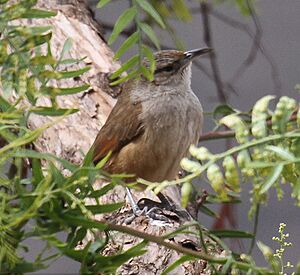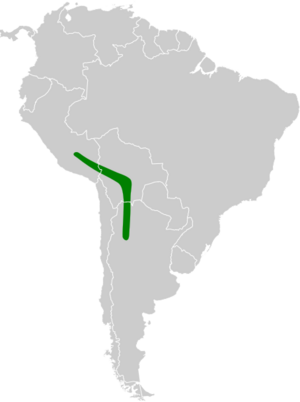Streak-fronted thornbird facts for kids
Quick facts for kids Streak-fronted thornbird |
|
|---|---|
 |
|
| Conservation status | |
| Scientific classification | |
| Genus: |
Phacellodomus
|
| Species: |
striaticeps
|
 |
|
The streak-fronted thornbird (Phacellodomus striaticeps) is a small bird found in South America. It belongs to the ovenbird family called Furnariidae. This bird is known for building interesting nests. You can find it in countries like Argentina, Bolivia, and Peru.
Contents
About This Bird's Family
Scientists group living things to understand how they are related. This is called taxonomy. The streak-fronted thornbird is part of the Phacellodomus group.
There are two main types, or subspecies, of the streak-fronted thornbird. They are called P. s. striaticeps and P. s. griseipectus. Some scientists are still studying if the second type is truly different from the first.
What Does It Look Like?
The streak-fronted thornbird is a small, slim bird. It is about 16 to 17 cm (6 to 7 in) long. It weighs around 23 to 29 g (0.8 to 1.0 oz). Both male and female birds look very similar.
Feathers and Colors
The main type of streak-fronted thornbird has a brownish face with a hint of reddish color. It has a dark brown stripe behind its eye. Its forehead has blackish and reddish colors with brown streaks. The top of its head is a lighter brown.
Its back is mostly dark brown. The wings are dark brown with some reddish-brown parts. The tail feathers are dark brown in the middle. The outer tail feathers become more reddish-brown.
The throat and belly are a dull white color. The sides of its chest are light gray-brown. Its lower belly and under-tail feathers are light reddish-brown.
Eyes, Beak, and Legs
The bird's eyes are dark brown or gray. Its upper beak is dark gray. The lower beak is a pale blue-gray, sometimes with a dark tip. Its legs and feet are greenish-gray or blue-gray.
Differences in Subspecies
The P. s. griseipectus subspecies looks a bit different. It does not have the reddish color on its face. Its back is darker, and its chest is grayer. Its lower belly is also a darker reddish-brown.
Where Does It Live?
The streak-fronted thornbird lives in the Andes mountains of South America.
Specific Locations
The P. s. striaticeps subspecies is found in Bolivia, starting from the La Paz area. It goes south into northern Argentina, reaching Catamarca and Tucumán provinces.
The P. s. griseipectus subspecies lives in southern Peru. You can find it in the Apurímac, Cuzco, and Puno regions.
Its Home Environment
This bird mostly lives in dry mountain areas with lots of bushes. It especially likes steep valleys. You might also see it in Polylepis woodlands. Sometimes, it lives near farms and human homes.
It can be found at high elevations, from 1,200 to 5,000 meters (3,900 to 16,400 ft) above sea level. However, it is most common between 1,500 to 3,000 meters (4,900 to 9,800 ft).
How It Behaves
Movement
The streak-fronted thornbird usually stays in the same area all year. However, some birds from the southernmost parts move to lower places after they have raised their young.
Feeding Habits
We don't know everything this bird eats. But we do know it eats Lepidoptera larvae, which are like caterpillars. It usually looks for food in pairs. They search for prey on the ground, on branches, and in moss or plant clumps.
Reproduction and Life Cycle
The streak-fronted thornbird lays its eggs in the southern summer. This is usually from November to March. It builds a very unique nest.
Building a Nest
The nest is like a tall cylinder made of thorny sticks. It can be up to 1.5 meters (5 ft) high! Inside, the bird lines a special chamber with shredded plants, hair, and feathers. It hangs the nest from a bush or tree. Often, the nest dangles over the edge of a cliff.
Eggs and Young
A female bird usually lays three or four eggs. Sometimes, she might lay five. Scientists do not yet know how long the eggs take to hatch. They also don't know how long it takes for the young birds to leave the nest.
Vocalization
The streak-fronted thornbird has a special song. It sounds like "wip wip weep weep WEEEP weep weep weep wip wip". The song gets louder and then softer. It is described as loud and "piercing."
Its calls are short, squeaky notes like "jit" or "tsip." It also makes a loud trill sound.
Status and Protection
The IUCN (International Union for Conservation of Nature) has looked at the streak-fronted thornbird. They have listed it as a species of "Least Concern." This means it is not in danger of disappearing.
Population and Threats
The bird lives across a large area. Even though we don't know exactly how many there are, the number of birds seems to be stable. There are no immediate threats to this bird.
It is considered uncommon in some places and common in others. This bird can handle some changes to its home, like moderate grazing by animals. The fact that it often lives near human homes shows it can adapt well.


